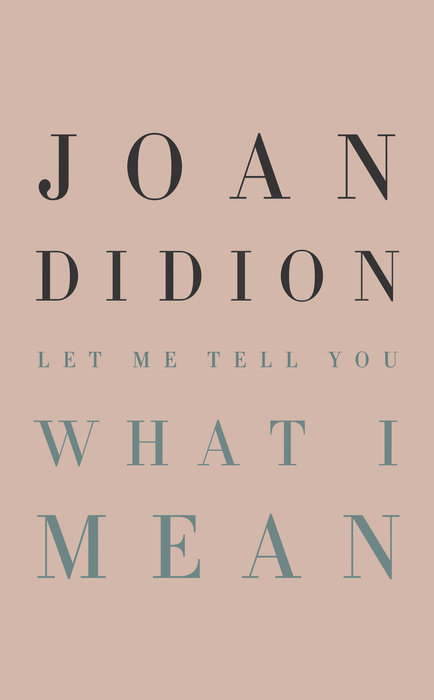
Any discussion about the giants of contemporary American letters must include Joan Didion. In Let Me Tell You What I Mean, a new collection of twelve nonfiction pieces ranging from 1968 to 2000 and gathered together for the first time, Didion tackles the press, art, her college years, writing, and her own self-doubt, which has been constant throughout her career and is to blame for the small number of short stories she has written. Witty, heartfelt, and insightful, the writing in Let Me Tell You What I Mean is always incisive and shows Didion as a perennial chronicler and keen observer obsessed with the present, the palpable, the real.
Even a brief discussion of every essay would lead to an incredibly long review because the depth of Didion’s observations invites discussion. However, looking at some standouts—and there are not weak essays here—is a much better because Didion’s writing demands careful attention. In each piece, she gracefully dances between the micro and the macro, constantly looking at very specific things and then somehow tying to something much larger effortlessly. In “Getting Serenity,” an essay from 1968 that, like five others, first appeared in the Saturday Evening Post, Didion takes in a Gambler’s Anonymous meeting in Gardena, a city in the South Bay region of Los Angeles County. She pulls readers into that meeting and shows them even the smallest details before moving on to the narratives of people looking for something better:
Gardena is the draw-poker capital of Los Angeles County (no stud, no alcoholic beverages, clubs closed between 5:00 a.m. and 9:00 a.m. and all day on Christmas Day; this is not Nevada but California, where there is only draw poker and that only on local option), and the seductive proximity of the poker clubs hung over this particular meeting like a paraphysical substance, almost as palpable as the portraits of Washington and Lincoln, the American flag, the plastic hydrangeas, and the table laid by the Refreshments Committee.
Didion doesn’t talk much about herself in her work, but there is plenty of her in the pages of this collection. What the very aptly titled Let Me Tell You What I Mean does is not only show Didion as a writer through her work but also allow her to show herself in her own words. In “Why I Write,” one of two crowning jewels in the book, the author contextualizes her work and then goes deeper to explore the why behind it all. There are no easy answers in the piece, which was originally a lecture she gave the University of California, Berkeley, and was later changed slightly to appear in the New York Times Book Review. However, the act of asking, and the insights she shares from that process, reveals a brutally honest thinker taking a step back to look at what she does for a living:
In many ways writing is the act of saying I, of imposing oneself upon other people, of saying listen to me, see it my way, change your mind. It’s an aggressive, even a hostile act. You can disguise its qualifiers and tentative subjunctives, with ellipses and evasions—with the whole manner of intimating rather than claiming, of alluding rather than stating—but there’s no getting around the fact that setting words on paper is the tactic of a secret bully, an invasion, an imposition of the writer’s sensibility on the reader’s most private space.
In a way, certain passages of this collection add up to something akin to a biography. In “On Being Unchosen by the College of One’s Choice,” for example, Didion delves into the “most conventional middle-class confrontation, the child vs. the Admissions Committee.” Her reaction to not being accepted into Stanford is an almost physical presence in the first part of the essay, but it later morphs into a look at how many parents attempt to live vicariously through their children and how college acceptances play into that. And don’t worry about Didion; as she says later in the essay, the rejection stung, but “it worked out all right.”
The last piece deserving a moment in the spotlight is “Last Words,” in which Didion tackles the death of writers and what happens to their work after, mostly centering the essay on Ernest Hemingway and what became of his letters, finished novels, and unfinished projects after his death by suicide in 1961. In here we see a seemingly detached Didion talking about other writers, and only later realize we’re in the presence of someone facing their own death on the page.
“I write entirely to find out what I’m thinking, what I’m looking,” writes Didion, and she does here. She’s been doing it for decades, and has done at outstanding job of it from the start. Her work is an eloquent mirror she holds up to herself and then points it at us, and we’re lucky to have that, and lucky to see her shimmering just beyond it.
***
Let Me Tell You What I Mean
by Joan Didion
Knopf; 192 p.
Follow Vol. 1 Brooklyn on Twitter, Facebook, and sign up for our mailing list.
